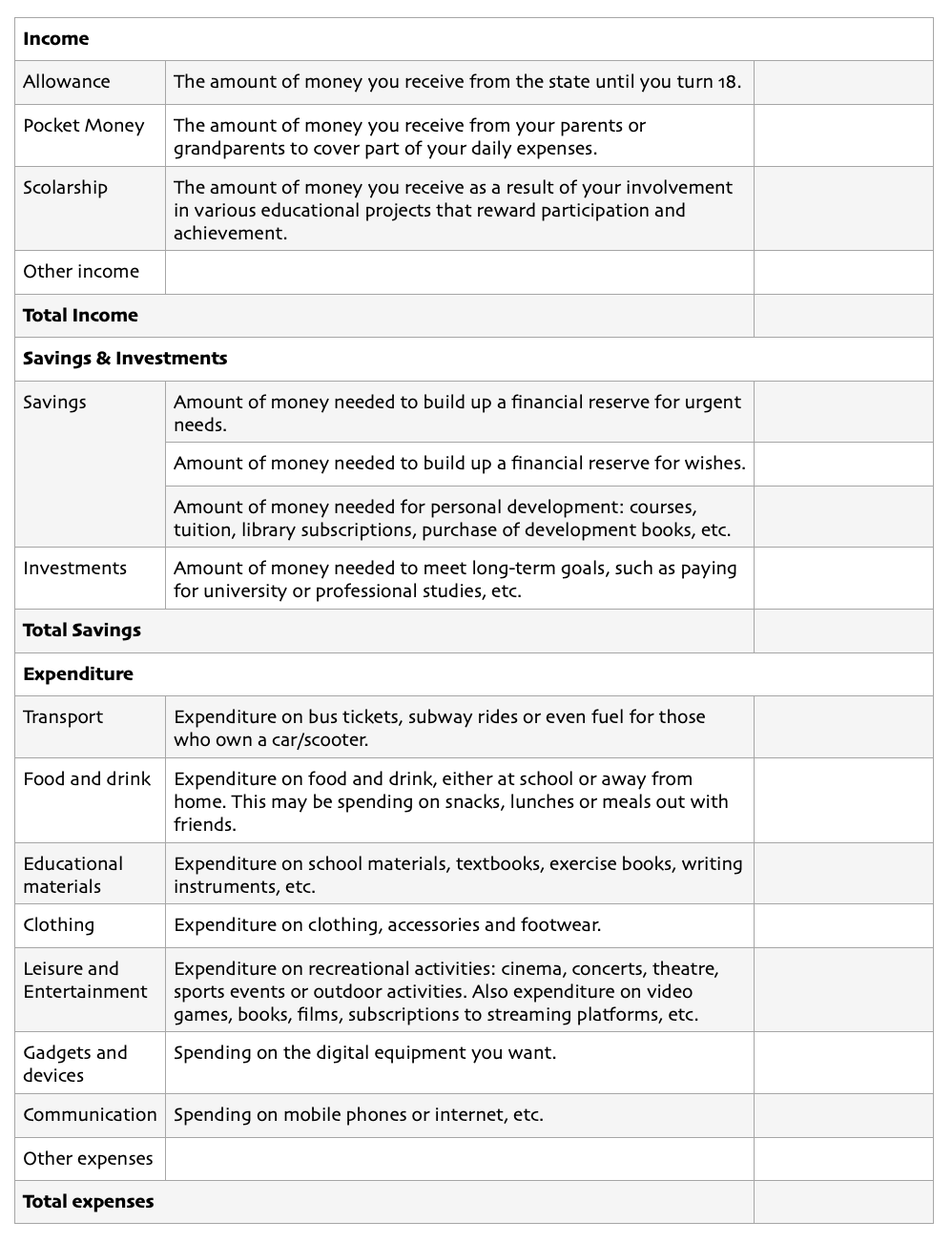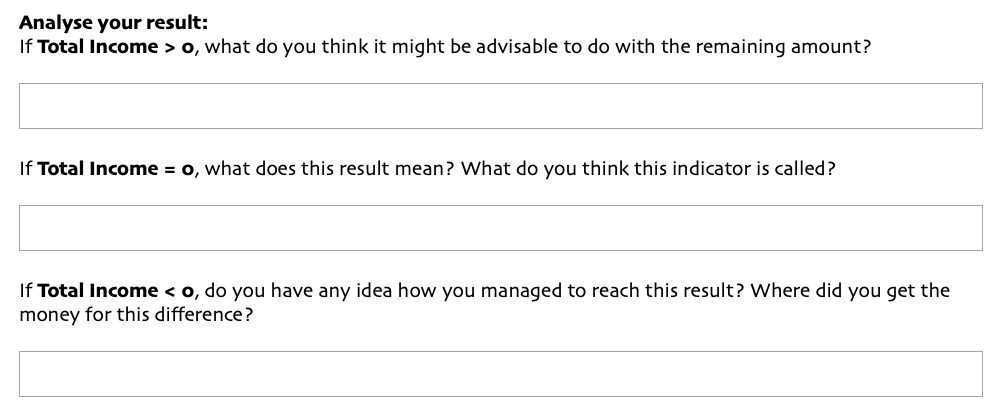9th Chapter | The adventure of financial planning
The crowded mall buzzed with excitement, with its tempting, glittering shop windows filled with sundry items, branded clothing, fancy gadgets and state-of-the-art devices. Everywhere she looked, Ada struggled with the lure of instant gratification, while George wisely compared prices and looked for the value of the products they needed for their project.
They had both arrived in town to canvass the market in order to budget for the community project in which they and their three friends had set out to discover the secret of cultural treasure on the one hand, and to teach the young people of the village and surrounding area about the world of money on the other.
In the two weeks since they all started contributing to the project's budget, they had already raised 180 lei.
Before setting off on their urban foray, Ada and George had a meeting with their team where they made a list of the expenses needed for their project.
Daniel: Well, first of all, we need to identify the things we're going to need for training. We could start with basic materials such as notebooks, pencils and educational worksheets. We might also need a space in which to run the training sessions. What else do you think we should include?
George: I think it's essential to have some teaching materials, such as charts, posters and maybe even a small library of books for the different age groups. We could also consider inviting speakers or organising workshops to make the sessions more attractive on different topics.
Ada: These are excellent suggestions! Now it's time to think about the costs. We should do some research to find out the prices of the items we need. I suggest comparing prices online and then visiting shops in town to get an idea. Once we have a rough estimate, we establish the shopping list needed and at the same time, assign estimated costs to each item.
Rareș: It's a very good plan. We should also think about how to raise funds for our budget in addition to our personal contribution. We could organise a fundraising event in the village, like a talent show or a small craft fair. We could involve the whole community to make this event a success. What do you think?
Daniel: I really like this idea! Involving the community will not only help us raise the money we need, but it will also help us raise awareness of the importance of education among our fellow citizens. We can set up donation boxes in local shops and tell our neighbours, family and friends about our project. We could even approach local small businesses and ask for their support.
Ana: Absolutely! We should also think about keeping track of our expenses once we go out in the field. It's important to have clarity on how we're going to spend the money and make sure we're within the budget we're aiming for.
George: I agree. We need to be accountable and show good stewardship of the funds entrusted to us. We can create a table of project income and expenditure to track costs, which we should update regularly. That way we can decide whether we need to adjust our budget or find additional sources of funding.
Ada: It sounds like we have a solid plan. Let's start with the organisation, create a budget and then ask for community support. I'm excited about the idea of making a positive impact on the lives of the younger children in our village! All 11 of my cousins will enjoy interacting with us. They love meeting cool people!
George: Me, I'm glad we're doing this together, too! With our determination and community support, we can make a real difference in informal and non-formal education. Ada and I could go into town and canvass the market to identify the materials we need and see what prices are on the shelf, but before we go, it would help to discuss what the exact spending categories are.
Daniel: First of all, as I said, we will need training materials such as notebooks, pencils, pens, school supplies, art props and other learning resources needed for the training sessions. In addition, we need educational charts, posters, cards and games that can enhance the learning experience, especially for younger learners.
Rareș: Next, I think we would need to find a venue for the training sessions. We need a laptop, but also a video projector or a TV screen, or a whiteboard or a flipchart with paper. All this could cost us quite a lot.
Ana: Such initiatives cost money, of course! But I imagine that we could appeal to the community centre managers who also run such projects and who might be willing to help us or support our project, either financially or with materials.
Ada: Good, we still need guest speakers or trainers. As we may also have expenses related to their fees or travel arrangements, I intend to persuade them to come pro bono and pay for their own travel.
Daniel: As we expect the training sessions to be at least 3 - 4 hours long with a break, we will need to provide snacks and water for the younger participants.
George: At the same time, there would also be costs for marketing and promoting the training programme in the community. We would probably need to print flyers, posters or banners and place ads in local newspapers or online platforms.
Daniel: I believe there will also be administrative costs, such as printing materials, stationery, photocopying, obtaining permits or other necessary licenses.
Ada: Yes, in addition, we will need to allocate part of the budget to evaluate the effectiveness of the training programme and collect feedback on its relevance to different age groups.
Ana: Because the project involves reaching out to children located in different parts of the region, there may be some transportation costs. We will need money for bus fares or fuel to get to the harder-to-reach areas.
Rareș: Last but not least, it is important to have a small reserve fund to cover unexpected expenses or unforeseen needs that may arise during the project.
Ana: I'll tell you one unexpected expense... My cousin, a history student, has been volunteering for some time at a school in the 6th district of Bucharest. She teaches remedial education in history. And in order to be able to carry out her work, she had to take out civil liability insurance as a trainer. Will we have to do the same?
George: Wow! I have no idea, but it's great that we thought of all the possible categories. Now we can see which ones could be optimised, reduced or saved. I'm sure we have a way to replace some of the activities and tools we want with cheaper ones, offered for free or on a barter basis, that will also allow us to deliver our project to the quality standards we set ourselves.
Dear reader, I would like these examples to give you an idea of the different expenses that our young protagonists must consider in order to create their project budget.
Of course, each project, depending on its specifics, may generate a different list of costs, which the project team is advised to consider in advance.
The same is true in real life with personal projects. Budgeting is the essential tool we can use to manage our money and analyse our financial behaviour, but also to plan our income and expenditure in a sustainable, continuous and predictable way.
DIARY PAGE | Personal Budget
Here's a short exercise to start with: Going to the cinema involves not just the price of the ticket, but money for the fuel of the car or the cost of the public transport ticket, the price of the snacks and drinks served in the cinema, the time invested with travelling to and watching the film, and one's energy. To get a sense of how the budget works, work out how much money you need for this leisure activity. Then, have a concrete discussion with your parents about how much the family should spend on this activity. Reflect by yourself on whether it is worth the "expense", or whether there are less expensive alternatives for spending your free time, and whether this money could be "saved" for the future (major long-life purchases or investment in a reserve fund for studies) or redirected to a social/humanitarian cause (individual donation).
To get a deeper understanding of the budget, think about yourself and how you manage your money now. In the table below, write down the amounts of your income, savings and expenses.

As you will easily realise, your income, savings and spending can vary depending on your personal priorities. It's important to take into account your needs and desires and to be responsible in managing your budget.
What is the difference between Income, Savings (+Investments) and Expenses?
[Total Income] = [Total Savings] - [Total Expenditure] = ...

Did you know that...
Budgeting is a fluid, constantly changing tool that can be calibrated and customised with a lot of discipline after many months of repeated planning.
By completing your personal budget, you can plan your income, the amounts you intend to set aside to achieve your goals, and the expenses you wish to incur, assumed.
The shopping list is a new exercise each of us can do when we do our weekly shopping. It's that simple! Before we go to the supermarket, we should try to put all the products we need on a list, to reduce the temptation of buying things we don't need, that are nicely packaged, that catch our eye or that feed a momentary craving.
So, the shopping list helps us to be more organised. Adults often end up shopping in the evenings after work when they are a little hungry. Neuro-marketing research shows that in this kind of context, we don't act rationally. We buy out of hunger, without thinking about what's in the fridge at home. We put things in the basket that we crave, new products that sometimes we never get to taste. Yes, that's how we end up wasting food and, yes, money too.
Bạn đang đọc truyện trên: AzTruyen.Top